Email a copy of 'The Survivalist's Odds 'n Sods:' to a friend
13 Comments
- Ad Barter and Sell at Simcour Trading PostA new site for individuals to barter and sell items of interest to other like-minded individuals
- Ad SOURCE FOR IVERMECTIN / HCQ, ANTIBIOTICS, ALL REGULAR MEDS“Mygenericstore” is a well-established pharmacy service that deals primarily with generic medicines produced by quality-assured manufacturers from developing countries.


Was homeless at one stage of my life.A pair of slacks,solid color button up shirt with collar,short hair,clean shaven,carried my stuff in a laptop computer bag,always had a book or newspaper.Nobody ever gave me a second glance.
Middle age white guy,so in this case I think the term “white privilege” might have helped.
Which of these two would receive a second glance:
1) Disheveled, dirty & smelly white guy.
2) A black guy wearing a pair of slacks,solid color button up shirt with collar,short hair,clean shaven,carried stuff in a laptop computer bag,always had a book or newspaper.
Do you think that maybe white privilege had nothing to do with it?
@ Spying Street lights – “The story of how San Diego teamed up with a major corporation to retrofit thousands of streetlights to monitor traffic flow and meet its climate change goals is also a story of the benign way that cities can inadvertently open a backdoor to surveillance.”
Climate change, surveillance, yes…I mentioned this recently in the comments section of another story. This approach to security creates a real dilemma for survivalism. The dilemma goes something like this…
Insecurity from x,y,z (economic collapse, EMP, climate change, nuclear war, whatever), is a future concern so we prep. So too does the state, but the state uses these concerns of insecurity to further limit everyone’s rights. In turn, this creates more insecurity and so everyone preps more, and then the state surveil’s more.
This process is called “the state of exception” in which what was once consider exceptional, a rare event, becomes the norm. Survivalism and surveillance have a relationship. We would be wise to acknowledge, understand and discuss that relationship as to see more clearly.
I would never wear that ‘bullet resistant’ hoodie with the expectation of ‘stopping a .44 Magnum’. Too soft and flexible. The fabric might be rated to stop a (more common) .45 ACP bullet from passing through the fabric around the head/hoodie area, but does anyone really think the kinetic energy delivered won’t still kill you as your skull is cracked or smashed?
There’s a reason why nobody in Mil/LE service wears anything like this…ever.
C’mon…
It is the body of the hoodie that is bulletproof rated, not the hood. And yes, beware of blunt trauma. But it sure beats getting pierced by bullets.
Yes, I understand that the focus is on the torso, but as stated within the article:
“the only product on the market to seamlessly and discreetly protect your body and head from bullets and knife slashing,” said Tran. “We have patented our bulletproof head technology to protect your head …[ ]… You won’t want to buy another bulletproof jacket without head protection ever again.”
While I certainly agree with you that something is better than nothing, I find their press piece to be a bit misguiding and in need of clarification.
Head wounds can bleed profusely and helmets are heavy and not exactly low key. If the hoodie can stop a ricochet, some shrapnel, flying glass, or a 22LR, then it’s certainly better than nothing. Plus, Kevlar and similar fibers are flame resistant and have high heat resistance, so the hoodie could help protect 50 percent of your body in fire or explosion. I don’t own one and I’m not planning on getting one, but I wouldn’t dismiss the idea.
I agree with JWR if you are in France or some jihadi hotbed i would rather have this and be incognito than not. The issue is blending covert with protection and this can do that.
https://violenceresponse.com/product/bulletproof-underwear-gabriel-down-under/
even creations like this might cover the femoral artery and give you that chance at survival in a shooting or even a bombing.
The T-shirt I wear will stop a 16# sledge hammer from penetrating but I’m pretty sure I’d still be pretty messed up after a swing or two.
After too many years of Law Enforcement and Military experiences, I have been told I stick out like a sore thumb. My head is on a swivel, and I am looking around. Granted, it usually keeps me out of issues, but in a SHTF, how do you transition? Don’t look around and hope/pray they leave you alone? That concept seems the exact opposite of being aware of your surroundings. How do you compromise?
I’ve worked on 5G technologies for the last 5 years. It’s true millimeter wave technologies don’t scale outside dense urban populations but that is a small part of 5G. Other bands in the 3 to 5 GHz range will also open up and they will have very high data rates. In addition, existing cell bands will be upgraded to a much improved LTE like data rate. There is not much spectrum available at 600 MHz really. GHz = billion herz MHz = million herz. Most current technology is 3 GHz and below.
Dan,
You make an important point. Even in these relatively safe times, I don’t want to stand out. I will lean against a building or tree and covertly scan the area. This also points to the importance of being part of a team. Even extreme vigilance can be defeated when only one of us is doing it.
Carry on
When I clicked on the NASA link, I was given a message: FORBIDDEN. Anybody else able to get through?
Carry on